nor did i when mine are 600+ divs (by the time i reach berlin 1000+ but mainly in the deployment poll)
Permanently Operating Factors - A Soviet LAN AAR
- Thread starter Myth
- Start date
-
We have updated our Community Code of Conduct. Please read through the new rules for the forum that are an integral part of Paradox Interactive’s User Agreement.
You are using an out of date browser. It may not display this or other websites correctly.
You should upgrade or use an alternative browser.
You should upgrade or use an alternative browser.
nor did i when mine are 600+ divs (by the time i reach berlin 1000+ but mainly in the deployment poll)
You need 10 000 manpower, or 5000 if you build only militia :wacko:, how that is even possible.
Its not lol. The max you can get till jun 1941 is about 3500 MP. That means about 450 divisions.You need 10 000 manpower, or 5000 if you build only militia :wacko:, how that is even possible.
Oh man, one of those screenshots shows very clearly the major fatal mistake I made in my campaign. I'm glad that nobody has spotted it yet.
Those two orders set me back by weeks in progress. I knew it was a risk, but I didn't know it would... yeah...
Those two orders set me back by weeks in progress. I knew it was a risk, but I didn't know it would... yeah...
Edzako: Your Lublin is my Suwalki, I think 
Delex: I could never use 400 divisions, that's too much for me. I prefer smaller, more nimble armies. It's just more my style.
Deus Eversor: Good grief, why would you ever need so many? :wacko:
Discomb: Which two are those? Driving northward into the swamp, and driving southward into the swamp?
Update probably tomorrow!
Delex: I could never use 400 divisions, that's too much for me. I prefer smaller, more nimble armies. It's just more my style.
Deus Eversor: Good grief, why would you ever need so many? :wacko:
Discomb: Which two are those? Driving northward into the swamp, and driving southward into the swamp?
Update probably tomorrow!
Well besides the obvious. I don't want to give away important plot points, so I'll comment on what it was after you post the update that reveals it anyway.
i never really fully used it xD
i usually fought on woth 100(defending)-200(pushing) only increasing to 300(germans berely stand) when the line stretches acros europe (hamburg-constantinople)
but usually most of that force waits till end of war in deployment pool cause i just made large number orders to produce so they were produced xD
after the war i have the time to deploy them (allies fight japan) and also i dont use them all just giant garrisons in important continents parts
by the time usa finaly gets the cold war gets hot i have up to 800 divs deployed (!!!)
but then i know i just won the game cause eurafrasia belongs to me and all i can get now is my slow army (goddamn tc) and that it until i produce zerg fleets (allies dont land anywhere cause i deploy 2 garrisons with engineers on every coastline(except baltic/mediterranean))
but back to aar i see that you are giving up your vital inteligence to your enemy by this aar... no wonder the sitzkrieg of yours lasted so long xD
i usually fought on woth 100(defending)-200(pushing) only increasing to 300(germans berely stand) when the line stretches acros europe (hamburg-constantinople)
but usually most of that force waits till end of war in deployment pool cause i just made large number orders to produce so they were produced xD
after the war i have the time to deploy them (allies fight japan) and also i dont use them all just giant garrisons in important continents parts
by the time usa finaly gets the cold war gets hot i have up to 800 divs deployed (!!!)
but then i know i just won the game cause eurafrasia belongs to me and all i can get now is my slow army (goddamn tc) and that it until i produce zerg fleets (allies dont land anywhere cause i deploy 2 garrisons with engineers on every coastline(except baltic/mediterranean))
but back to aar i see that you are giving up your vital inteligence to your enemy by this aar... no wonder the sitzkrieg of yours lasted so long xD
Discomb: k 
Deus Eversor: Nah, this was a LAN we played two years ago. The game's over
Update coming up!
Deus Eversor: Nah, this was a LAN we played two years ago. The game's over
Update coming up!
23 kilometers south of Vilnius
May 17, 1942
Timoshenko coughed to clear his throat as he surveyed the map composition arrayed before him. It was strange, but apparently he did not have a single map detailing the area he was operating in. Thus, the table was covered by a map for Lithuania, another for East Prussia and a third for northern Belarus. Aides were updating the map as soon as information came in, pushing counters here or there. Recently, a counter denoting the German corps that had been standing on Grodno had been removed and placed on a stack with the others at Bialystok. Thus, the way was free for Timoshenko’s 1st Belarusian Front to regain the territory it had lost in the previous week. Unfortunately, this good news came paired with even more worries for him. that was the nature of war, of course, and this war in particular. The Baltic and Belarusian theaters were a collective hotbed of chaos and carnage.
The first other development he had to worry about was another German attempt to regain Suwalki. Antonov’s 2nd Baltic Front was a nut, albeit a hard to crack one, between three German attacks. Along one axis, a dozen German divisions were assaulting from Torun. Along another, nine divisions were pushing northward from Bielsk. Finally, 21 divisions were attacking from Bialystok. In the face of this concentrated assault, Antonov could only muster 15 divisions and, in fact, his own corps had not yet reached the battlefield, it as still marching from Alytus. Thus, Suwalki seemed likely to fall, yet again. Though obviously Antonov’s Front would be thrashed in the process and likely spell the doom of Timoshenko’s broad thrust from the north, it wouldn’t be a disastrous defeat in its own right. It would only seal the doom of Antonov’s two mobile corps, which wasn’t a debilitating loss, in absolute terms coldly calculated. Even so, it was a defeat he’d like to avoid. Timoshenko sighed, by the end of the war Suwalki was likely to be the most shattered patch of earth in existence.
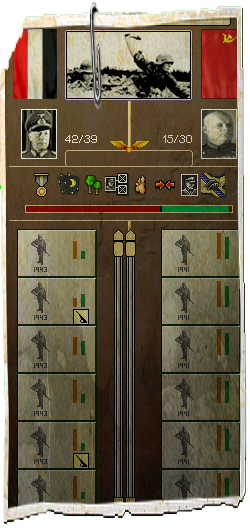
Ye Gods, another battle around Suwalki! And with bad odds, too.
At least the 3rd Belarusian Front, under Colonel General Chistyakov M.N., based in the potentially debilitating near bad of Brest-Litovsk, was contributing to the battle around Suwalki. He had a keep strategic mind, and on his own initiative decided to attack the Germans, led by Colonel General Rommel, in the rear around Bielsk. Rommel’s units began suffering badly almost immediately, being under the pressure of twenty-four divisions behind them, which was nearly three times their own strength. Chistyakov knew that his own forces were in grave danger and that attacking Rommel was the best possibility for saving his Front. Zhukov’s push toward Kowel and opening up a supply route to Chistyavok from the south was gaining steam but would still take a few days and it was unknown when the Germans would arrive at Pinsk and cut it off, though there were indications that they had actually broken off that push to head toward Baranowicze. Timoshenko did not trust those reports, however. That would seem to be a very daft thing to do, to him. Regardless, Chistyakov was in danger of complete encirclement and then likely destruction and Bielsk offered an alternative route of supply and of escape. Of course, if Suwalki fell then it was slightly worthless, though victory there may potentially allow Antonov’s mobile units to survive by giving them an avenue of retreat.
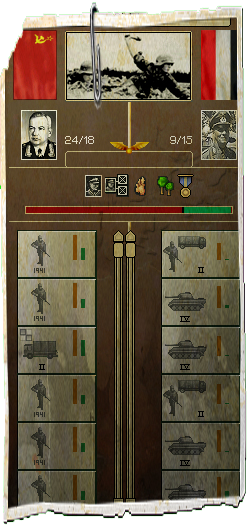
The battle for Bielsk.
Of course, Timoshenko had not yet noted the most obvious and possibly most important aspect of a victory at Bielsk. It would isolate von Kleist’s and Hausser’s massive combined armored force around Bialystok and Slonim. Together, those two armies counted forty-five armored and motorized infantry divisions and their destruction would be a grave blow to German ambitions in Eastern Europe.
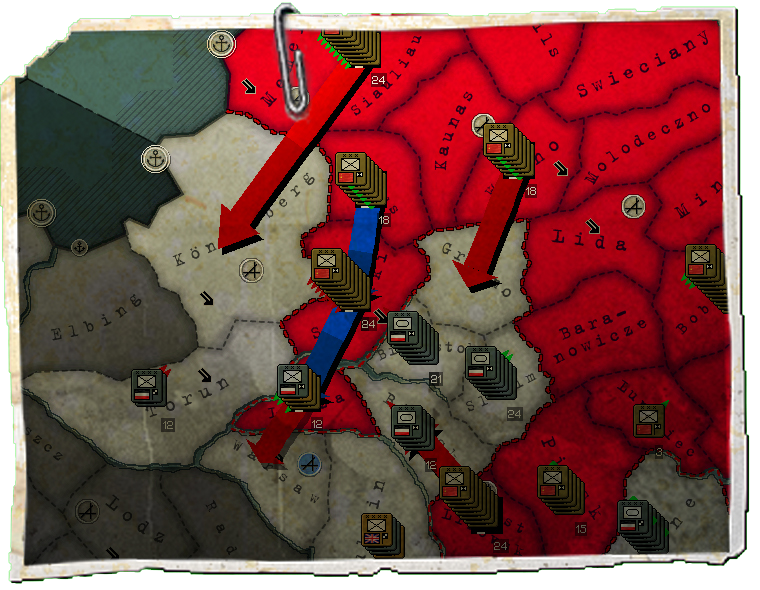
The hotbed of chaos – the Baltic and Belarusian theaters of war at 0800, May 16th.
Thus, as he looked at the maps, Timoshenko saw the potential events of the next hours and days in his head. Konigsberg fell by the end of the 16th. Timoshenko was expecting reports of a renewed German push on Pinsk within hours. One of Antonov’s mobile corps was pushing on Warsaw, which lay undefended, and the other was supporting the attack on Bielsk from Lomza. The battle for Suwalki was raging with no conceivable end save defeat unless some miracle occurred. Konigsberg would doubtless receive a counterattack, given the 27 German and British divisions massed at Elbing. Baranowicze was stripped of all its defenses a second time, and Luniniec seemed within days of falling to the spearheads of von Kluge’s armor. It was a race to see who could encircle and fatally rupture whose front first.
May 17, 1942
Timoshenko coughed to clear his throat as he surveyed the map composition arrayed before him. It was strange, but apparently he did not have a single map detailing the area he was operating in. Thus, the table was covered by a map for Lithuania, another for East Prussia and a third for northern Belarus. Aides were updating the map as soon as information came in, pushing counters here or there. Recently, a counter denoting the German corps that had been standing on Grodno had been removed and placed on a stack with the others at Bialystok. Thus, the way was free for Timoshenko’s 1st Belarusian Front to regain the territory it had lost in the previous week. Unfortunately, this good news came paired with even more worries for him. that was the nature of war, of course, and this war in particular. The Baltic and Belarusian theaters were a collective hotbed of chaos and carnage.
The first other development he had to worry about was another German attempt to regain Suwalki. Antonov’s 2nd Baltic Front was a nut, albeit a hard to crack one, between three German attacks. Along one axis, a dozen German divisions were assaulting from Torun. Along another, nine divisions were pushing northward from Bielsk. Finally, 21 divisions were attacking from Bialystok. In the face of this concentrated assault, Antonov could only muster 15 divisions and, in fact, his own corps had not yet reached the battlefield, it as still marching from Alytus. Thus, Suwalki seemed likely to fall, yet again. Though obviously Antonov’s Front would be thrashed in the process and likely spell the doom of Timoshenko’s broad thrust from the north, it wouldn’t be a disastrous defeat in its own right. It would only seal the doom of Antonov’s two mobile corps, which wasn’t a debilitating loss, in absolute terms coldly calculated. Even so, it was a defeat he’d like to avoid. Timoshenko sighed, by the end of the war Suwalki was likely to be the most shattered patch of earth in existence.

Ye Gods, another battle around Suwalki! And with bad odds, too.
At least the 3rd Belarusian Front, under Colonel General Chistyakov M.N., based in the potentially debilitating near bad of Brest-Litovsk, was contributing to the battle around Suwalki. He had a keep strategic mind, and on his own initiative decided to attack the Germans, led by Colonel General Rommel, in the rear around Bielsk. Rommel’s units began suffering badly almost immediately, being under the pressure of twenty-four divisions behind them, which was nearly three times their own strength. Chistyakov knew that his own forces were in grave danger and that attacking Rommel was the best possibility for saving his Front. Zhukov’s push toward Kowel and opening up a supply route to Chistyavok from the south was gaining steam but would still take a few days and it was unknown when the Germans would arrive at Pinsk and cut it off, though there were indications that they had actually broken off that push to head toward Baranowicze. Timoshenko did not trust those reports, however. That would seem to be a very daft thing to do, to him. Regardless, Chistyakov was in danger of complete encirclement and then likely destruction and Bielsk offered an alternative route of supply and of escape. Of course, if Suwalki fell then it was slightly worthless, though victory there may potentially allow Antonov’s mobile units to survive by giving them an avenue of retreat.

The battle for Bielsk.
Of course, Timoshenko had not yet noted the most obvious and possibly most important aspect of a victory at Bielsk. It would isolate von Kleist’s and Hausser’s massive combined armored force around Bialystok and Slonim. Together, those two armies counted forty-five armored and motorized infantry divisions and their destruction would be a grave blow to German ambitions in Eastern Europe.

The hotbed of chaos – the Baltic and Belarusian theaters of war at 0800, May 16th.
Thus, as he looked at the maps, Timoshenko saw the potential events of the next hours and days in his head. Konigsberg fell by the end of the 16th. Timoshenko was expecting reports of a renewed German push on Pinsk within hours. One of Antonov’s mobile corps was pushing on Warsaw, which lay undefended, and the other was supporting the attack on Bielsk from Lomza. The battle for Suwalki was raging with no conceivable end save defeat unless some miracle occurred. Konigsberg would doubtless receive a counterattack, given the 27 German and British divisions massed at Elbing. Baranowicze was stripped of all its defenses a second time, and Luniniec seemed within days of falling to the spearheads of von Kluge’s armor. It was a race to see who could encircle and fatally rupture whose front first.
Deus Eversor: *ominous voice* We shall see...
I'll probably get an update ready by Friday, though given that my essays will be finally handed in on Friday I may be too busy going over them and putting on final touches and could only have one for Saturday. We'll see.
I'll probably get an update ready by Friday, though given that my essays will be finally handed in on Friday I may be too busy going over them and putting on final touches and could only have one for Saturday. We'll see.
If I were Rommel I would be doing my best to not screw this up 
In case of defeat he has only 2 options, G***G or some alternative camp
In case of defeat he has only 2 options, G***G or some alternative camp
Last edited:
Indeed, BritishImperial is right. Let's not tread that ground. 'Nuff said.If I were Rommel I would be doing my best to not screw this up
In case of defeat he has only 2 options, GULAG or some alternative NAZI camp
Myth - just wanted you to know I am slowly moving my way through in an attempt to get caught up. Hopefully I'll be all the way there soon. Great to see you still working on this.
I changed my post, you should change your reply to my post too. I forgot that soviet cc were forbidden to mention too, sorry.
Edzako: Tsk tsk, naughty Edzako  But yeah, Rommel's not in the best position in the world at the moment
But yeah, Rommel's not in the best position in the world at the moment 
BritishImperial: The invisible post! Aaaaaaaaa!
coz1: Excellent, coz! It did straggle a bit at times (there were what, three or four distinct major pauses?) but my plan was always to finish it, I felt (and Discomb felt too, I think) that this war we had was just that good that it deserved to be finished. I'm hoping to get the gears in motion to get LtHbB back up and running too, but rusty mechanics and inertia are apparently a bigger foe than I thought. Ah well, we plan on finishing that too
It did straggle a bit at times (there were what, three or four distinct major pauses?) but my plan was always to finish it, I felt (and Discomb felt too, I think) that this war we had was just that good that it deserved to be finished. I'm hoping to get the gears in motion to get LtHbB back up and running too, but rusty mechanics and inertia are apparently a bigger foe than I thought. Ah well, we plan on finishing that too 
Update coming up!
BritishImperial: The invisible post! Aaaaaaaaa!
coz1: Excellent, coz!
Update coming up!
The Kremlin
May 18, 1942
Vasilevskij paced back and forth behind his desk at the STAVKA headquarters set up within the Kremlin. Stalin had ordered him to stay in Moscow for, to his eyes, it seemed like Vasilevskij’s 1st Tank Army would never actually get into combat; it was still in transit somewhere behind the Dnepr River, Vasilevskij was unsure quite where it was at the moment though he knew his chief of staff would notify him as soon as it neared the frontline. Stalin had given him permission to rejoin it once it reached the front, but until then he had to stay back and direct the war from a strategist’s holistic point of view. Vasilevskij felt somewhat cheated; Zhukov was out making a name for himself, as was Timoshenko and many of the other Front and Army commanders. However, they were still only Front commanders, excepting Timoshenko who was also a theater commander. Vasilevskij had the chance to be the director of the entire war for what seemed to be its climax. It was a unique opportunity for him, his career and how history judged him.
And, to be honest to himself, he had to admit that he seemed to be presiding over an increasingly favorable turn of events. Of course, the actions being taken were generally quite risky and thus had much potential for disaster, but that potential had yet to be realized whereas the auspicious dividends seemed just out of his reach but moving closer. Among the first reports concerning the 17th that Vasilevskij received were of the battle around Torun. The two mobile corps of Malinovskij’s 3rd Baltic Front had reached Konigsberg a day or two earlier and after a brief period of reorganization had continued their drive by pushing toward Torun, in Poland. There they ran into four corps, twelve divisions, of German troops. These troops, however, were heavily engaged in pushing toward Suwalki and had been badly battered in previous fights as well. Their combat value was relatively little and it seemed likely from what Vasilevskij was reading that that a penetration might be made at Torun that could allow the Baltic Fronts to exploit into the interior of Poland.
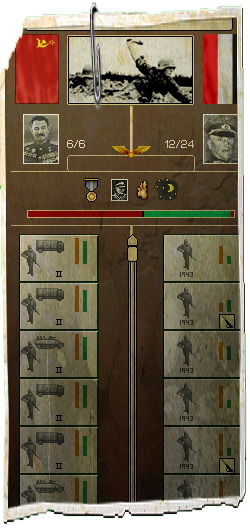
The battle for Torun.
The picture at Suwalki was less clear cut. Antonov’s 2nd Baltic Front had been defeated and was in full retreat, minus its mobile units at Lomza, toward Alytus. At the same time, however, nearly the entirey of Berzarin’s 1st Baltic Front had entered the fray there and was holding the gap, despite the very heavy pressure the Germans were placing on it. Nevertheless, it seemed inevitable that Berzarin would be overrun as well, and then Antonov’s mobile corps would likely be pocketed and broken by concentric German assaults unless Bielsk fell quickly.
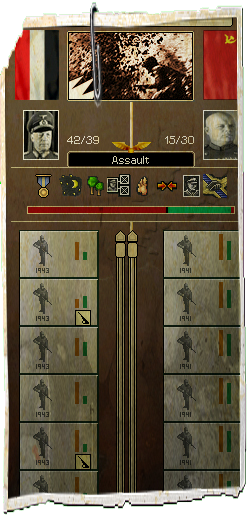
Yet another battle for Suwalki, the count was probably in double digits by this point in time.
Further east, the German thrust toward Baranowicze seemed to be on its way to failure. The Soviet units recently mauled at Pinsk, belonging to the nomadic 2nd Belarusian Front under the command of Field Marshal Fedorenko, were making yet another stand in the face of the enemy, at Baranowicze. Their history during the war had not been a glamorous one; they had been pushed from Bielsk to Brest-Litovsk, then to Pinsk, and finally to Baranowicze. There, however, they seemed to be finally making a stand that could end victoriously. Von Manstein’s six divisions were grinding to a halt against the resistance being posed by the twelve divisions of the 2nd Belarusian that were at Baranowicze. Vasilevskij was unsure where the other half of the Front was.
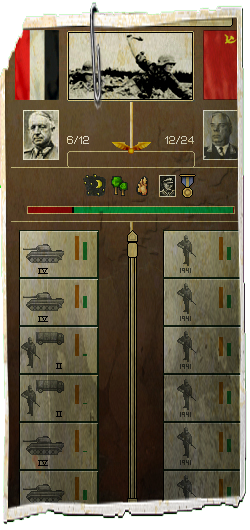
Another battle for Baranowicze.
In another piece of bad news, which might actually be good news in disguise, it seemed that the push by one of Antonov’s mobile corps on Warsaw was petering out against resistance in the fatal urban landscape. Though this meant not being able to make Warsaw an urban anchor around which battle could safely cavort, it also meant that the Soviets were that much less overstretched. Vasilevskij did honestly believe that they were overstretched as it was; there were still gaps in the front and no way to plug them without weakening the front elsewhere. Thus, a failed gamble for Warsaw would turn into a stronger position at Lomza.
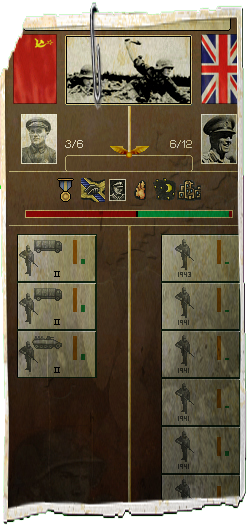
The battle for Warsaw.
Thus, Vasilevskij looked upon the map that was tacked up quite handsomely to his wall. The frontline was contorting savagely, and Vasilevskij had markers on nearly ten locations that indicated that battles were or had been going on, on the 17th. He shook his head. Usually wars were punctuated by intense periods of violence interspersed by periods of rest and reorganization. This war, however, seemed as close to Clausewitz’s archetype of absolute war as was possible: there was not yet any real drop in the sheer level of carnage yet, and particularly not in the north.
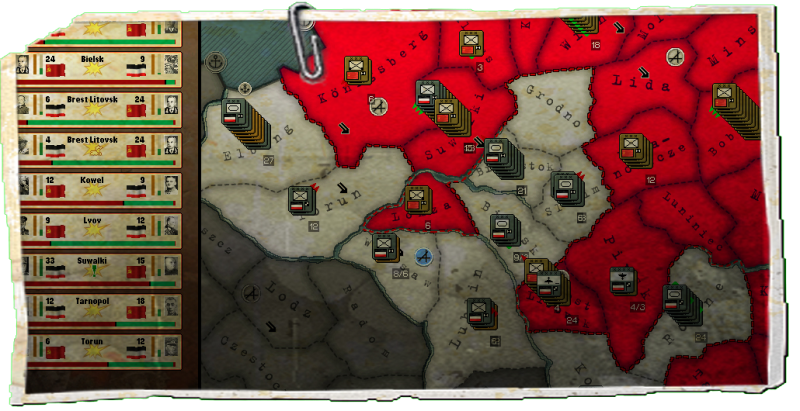
The northern theater of operations with its contorted front and its many battles.
Vasilevskij shook his head again and continued pacing behind his desk. As an apparently successful strategist thus far, he had no major crises to manage as he would in defeat. He simply had the crisis of creating a victory to attempt, but that was already in the works.
May 18, 1942
Vasilevskij paced back and forth behind his desk at the STAVKA headquarters set up within the Kremlin. Stalin had ordered him to stay in Moscow for, to his eyes, it seemed like Vasilevskij’s 1st Tank Army would never actually get into combat; it was still in transit somewhere behind the Dnepr River, Vasilevskij was unsure quite where it was at the moment though he knew his chief of staff would notify him as soon as it neared the frontline. Stalin had given him permission to rejoin it once it reached the front, but until then he had to stay back and direct the war from a strategist’s holistic point of view. Vasilevskij felt somewhat cheated; Zhukov was out making a name for himself, as was Timoshenko and many of the other Front and Army commanders. However, they were still only Front commanders, excepting Timoshenko who was also a theater commander. Vasilevskij had the chance to be the director of the entire war for what seemed to be its climax. It was a unique opportunity for him, his career and how history judged him.
And, to be honest to himself, he had to admit that he seemed to be presiding over an increasingly favorable turn of events. Of course, the actions being taken were generally quite risky and thus had much potential for disaster, but that potential had yet to be realized whereas the auspicious dividends seemed just out of his reach but moving closer. Among the first reports concerning the 17th that Vasilevskij received were of the battle around Torun. The two mobile corps of Malinovskij’s 3rd Baltic Front had reached Konigsberg a day or two earlier and after a brief period of reorganization had continued their drive by pushing toward Torun, in Poland. There they ran into four corps, twelve divisions, of German troops. These troops, however, were heavily engaged in pushing toward Suwalki and had been badly battered in previous fights as well. Their combat value was relatively little and it seemed likely from what Vasilevskij was reading that that a penetration might be made at Torun that could allow the Baltic Fronts to exploit into the interior of Poland.

The battle for Torun.
The picture at Suwalki was less clear cut. Antonov’s 2nd Baltic Front had been defeated and was in full retreat, minus its mobile units at Lomza, toward Alytus. At the same time, however, nearly the entirey of Berzarin’s 1st Baltic Front had entered the fray there and was holding the gap, despite the very heavy pressure the Germans were placing on it. Nevertheless, it seemed inevitable that Berzarin would be overrun as well, and then Antonov’s mobile corps would likely be pocketed and broken by concentric German assaults unless Bielsk fell quickly.

Yet another battle for Suwalki, the count was probably in double digits by this point in time.
Further east, the German thrust toward Baranowicze seemed to be on its way to failure. The Soviet units recently mauled at Pinsk, belonging to the nomadic 2nd Belarusian Front under the command of Field Marshal Fedorenko, were making yet another stand in the face of the enemy, at Baranowicze. Their history during the war had not been a glamorous one; they had been pushed from Bielsk to Brest-Litovsk, then to Pinsk, and finally to Baranowicze. There, however, they seemed to be finally making a stand that could end victoriously. Von Manstein’s six divisions were grinding to a halt against the resistance being posed by the twelve divisions of the 2nd Belarusian that were at Baranowicze. Vasilevskij was unsure where the other half of the Front was.

Another battle for Baranowicze.
In another piece of bad news, which might actually be good news in disguise, it seemed that the push by one of Antonov’s mobile corps on Warsaw was petering out against resistance in the fatal urban landscape. Though this meant not being able to make Warsaw an urban anchor around which battle could safely cavort, it also meant that the Soviets were that much less overstretched. Vasilevskij did honestly believe that they were overstretched as it was; there were still gaps in the front and no way to plug them without weakening the front elsewhere. Thus, a failed gamble for Warsaw would turn into a stronger position at Lomza.

The battle for Warsaw.
Thus, Vasilevskij looked upon the map that was tacked up quite handsomely to his wall. The frontline was contorting savagely, and Vasilevskij had markers on nearly ten locations that indicated that battles were or had been going on, on the 17th. He shook his head. Usually wars were punctuated by intense periods of violence interspersed by periods of rest and reorganization. This war, however, seemed as close to Clausewitz’s archetype of absolute war as was possible: there was not yet any real drop in the sheer level of carnage yet, and particularly not in the north.

The northern theater of operations with its contorted front and its many battles.
Vasilevskij shook his head again and continued pacing behind his desk. As an apparently successful strategist thus far, he had no major crises to manage as he would in defeat. He simply had the crisis of creating a victory to attempt, but that was already in the works.
so close and yet so away... ;[
i see we infuriated our ennemy eh? ;]
flails about like never before ;o
i see we infuriated our ennemy eh? ;]
flails about like never before ;o
i admire your ability to actually control a whole front without pausing it, and against a player with a brain, too. i would be swamped and crying on the floor with confusion.
i admire your ability to actually control a whole front without pausing it, and against a player with a brain, too. i would be swamped and crying on the floor with confusion.
Yeah, I myself spend most time with the game paused, only unpausing for action.
which is realistic really, as when unpaused hours pass like seconds. it'd be like trying to organise a war while on speed or something.

